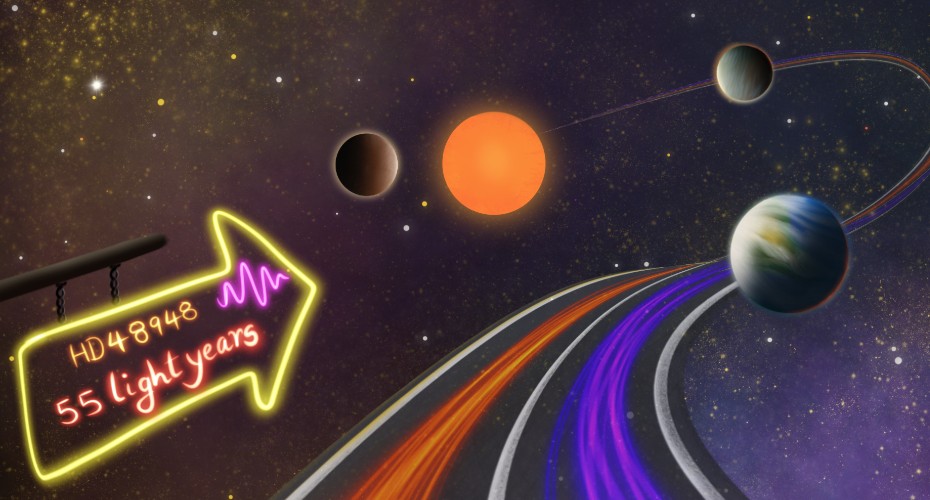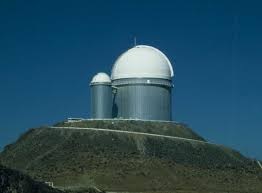From The University of Exeter (UK)
6.24.24
Duncan Sandes

Artistic Impression of planetary system HD48948 which is located at a distance of 55 light-years from Earth. The Voyager 1 spacecraft with its current speed would take almost one million years to reach HD48948. Image Credits: Soumita Samanta (https://www.soumitasamanta.com)
Astronomers have discovered three potential “super-Earth” exoplanets orbiting a relatively nearby orange dwarf star. This groundbreaking find was made by an international team of researchers led by Dr Shweta Dalal from the University of Exeter.
The exoplanets are orbiting Star HD 48498, located approximately 55 light-years from Earth. These planets revolve around their host star in 7, 38, and 151 Earth days, respectively. Notably, the outermost exoplanet candidate resides in the habitable zone of its host star, where conditions could allow liquid water to exist without boiling or freezing. This region, often referred to as the Goldilocks zone, is considered ideal for potentially supporting life.
The researchers highlight the importance of this discovery, noting that this orange star is somewhat similar to our Sun and represents the closest planetary system to host a Super-Earth in the habitable zone around a Sun-like star.
The study detailing these findings was published in the journal MNRAS on June 24th, 2024.
Dr Dalal said: “The discovery of this Super-Earth in the habitable zone around an orange star is an exciting step forward in our quest to find habitable planets around solar-type stars.”
These potential Super-Earths, planets with a mass greater than Earth but significantly less than the Solar System’s ice giants Uranus and Neptune, were identified through the HARPS-N Rocky Planet Search program. Over a decade, the team collected nearly 190 high-precision radial velocity measurements using the HARPS-N spectrograph.


Radial velocity measurements, which track the star’s subtle movements caused by orbiting planets, are crucial in such discoveries.



By analyzing the spectrum of light from the star, researchers can determine whether it is moving towards us (blueshift) or away from us (redshift). To ensure the accuracy of their findings, the team employed various methodologies and comparative analyses.
The research revealed three planetary candidates with minimum masses ranging from 5 to 11 times that of Earth. The team suggests that the proximity of the star, combined with the outermost planet’s favourable orbit, makes this system a promising target for future high-contrast direct imaging and high-resolution spectroscopic studies.
Dr Dalal added: “This discovery highlights the importance of long-term monitoring and advanced techniques in uncovering the secrets of distant star systems. We are eager to continue our observations and look for additional planets in the system.”
This discovery opens new doors for understanding planetary systems and the potential for life beyond our solar system.
See the full article here.
Comments are invited and will be appreciated, especially if the reader finds any errors which I can correct.
five-ways-keep-your-child-safe-school-shootings
Please help promote STEM in your local schools.
The University of Exeter (UK) is a public research university in Exeter, Devon (UK). It was founded and received its royal charter in 1955, although its predecessor institutions, St Luke’s College, Exeter School of Science, Exeter School of Art, and the Camborne School of Mines were established in 1838, 1855, 1863, and 1888 respectively. In post-nominals, the University of Exeter is abbreviated as Exon. (from the Latin Exoniensis), and is the suffix given to honorary and academic degrees from the university.
The university has four campuses: Streatham and St Luke’s (both of which are in Exeter); and Truro and Penryn (both of which are in Cornwall). The university is primarily located in the city of Exeter, Devon, where it is the principal higher education institution. Streatham is the largest campus containing many of the university’s administrative buildings. The Penryn campus is maintained in conjunction with Falmouth University (UK) under the Combined Universities in Cornwall (CUC) initiative. The Exeter Streatham Campus Library holds more than 1.2 million physical library resources, including historical journals and special collections. The annual income of the institution is over £450 million of which £80 million is from research grants and contracts, with an expenditure of £420 million.
Exeter is a member of the Russell Group of research-intensive UK universities and is also a member of Association of Commonwealth Universities, the European University Association (EU), and and an accredited institution of the Association of MBAs (AMBA).


